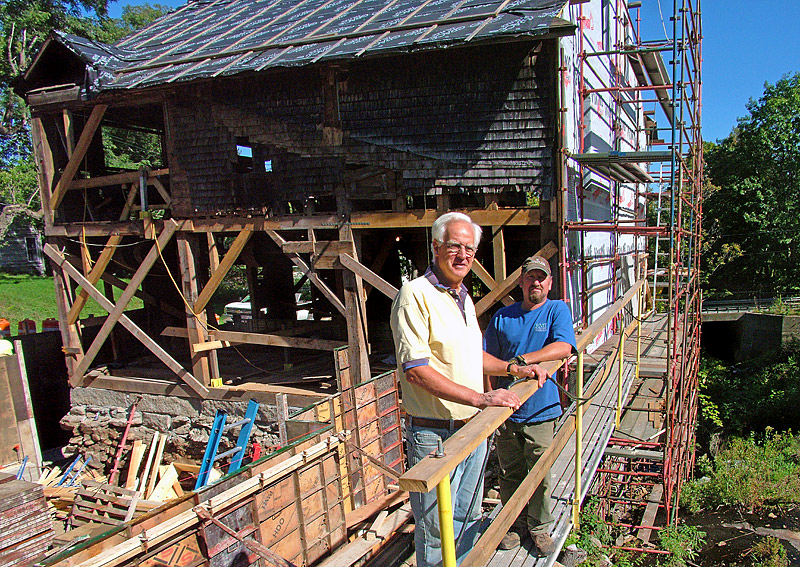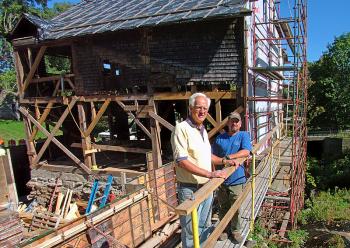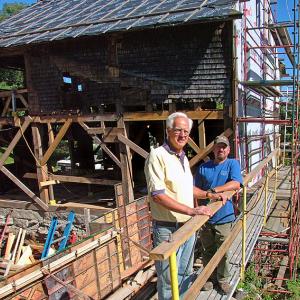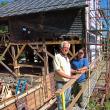19th-Century flour, 20th-Century dowels, 21st-Century promise
 Tony Grassi, of Camden, left, is giving the 19th-Century Freedom Falls Mill a 21st-Century makeover as a commercial property, complete with a hydroelectric generator that will supply the power for the building. Grassi is pictured at the mill with project foreman Jim Rorden, of Cold Mountain Builders. (Photo by Ethan Andrews)
Tony Grassi, of Camden, left, is giving the 19th-Century Freedom Falls Mill a 21st-Century makeover as a commercial property, complete with a hydroelectric generator that will supply the power for the building. Grassi is pictured at the mill with project foreman Jim Rorden, of Cold Mountain Builders. (Photo by Ethan Andrews)
 Tony Grassi, of Camden, left, is giving the 19th-Century Freedom Falls Mill a 21st-Century makeover as a commercial property, complete with a hydroelectric generator that will supply the power for the building. Grassi is pictured at the mill with project foreman Jim Rorden, of Cold Mountain Builders. (Photo by Ethan Andrews)
Tony Grassi, of Camden, left, is giving the 19th-Century Freedom Falls Mill a 21st-Century makeover as a commercial property, complete with a hydroelectric generator that will supply the power for the building. Grassi is pictured at the mill with project foreman Jim Rorden, of Cold Mountain Builders. (Photo by Ethan Andrews)
Old grist mills don't always get a second chance, never mind a third.
For much of 19th Century and half of the 20th, the one on Sandy Stream in Freedom, like mills in many New England towns, was a focal point of the community and an economic engine for the village and surrounding area.
By the 21st Century, however, it had fallen into such disrepair that it seemed poised to fall into the very stream that once turned its millstones and lathes.
This might have been the end of the story if not for an ambitious plan by Tony Grassi, of Camden, who broke ground on a full-scale renovation of the building in April.
By the end of the year, he plans to have revived the power generating capabilities of the adjacent dam and made the commercial space in the building available for occupancy. In time, and if all goes well, the mill might even return, in a post-millennial way, to being a focal point of the community and economic engine for the area.
Grassi, a retired investment banker and former chairman of the Nature Conservancy, is not new to big environmentally and socially progressive projects. In 2002 he and his wife Sally bought a waterfront parcel in Camden and set out to build a 3,500-square-foot home that produced no net greenhouse gas emissions.
In interviews with The New York Times and other publications, Grassi conceded that building anything new presented a problem of consumed resources. To minimize the impact of the Camden home — actually a cluster of several buildings — the Grassis meticulously swapped out standard building materials known to contain toxins — PVC pipe, fiberglass insulation and plywood among others — with safer counterparts.
The house incorporated photovoltaic panels for electricity and geothermal heating and efficiencies to conserve fuel.
Several years on, Grassi said the home has performed beautifully in many regards. But it has come up naggingly shy of its zero-emissions target. It was partly through this lens that he viewed what he now calls the Mill at Freedom Falls.
Built in 1834 on an outlet from Sandy Pond, the grist mill operated successfully during first half of the 19th century but saw diminishing returns as agricultural production shifted West, according to a history on the project’s website.
In 1894, it was refitted as a woodturning mill and changed ownership. In a bit of small-town vertical integration, a sawmill was built across the stream in 1913 allowing the mill to produce a wide range of turned wood products from matchsticks to tool handles and dowels until the 1960s when economic factors, including mass-produced plastics and a dwindling supply of local hardwood, forced the operation to close.
Grassi began researching the mill in 2008. Permitting alone was a major project, requiring a change in local zoning, compliance with federal energy regulations related to the dam and adherence to standards of the National Register of Historic Places, to which the mill was added in March.
In April, Grassi and team including two building contractors, engineers, an architect and a soil scientist started rebuilding the mill from the bottom up.
The granite foundation had to be reconstructed on the downstream side but other portions of the original footing and timber frame remained intact. The same could not be said of the four additions built in the 20th century, which Grassi said were undertaken with less care.
Historic preservation standards required that he reconstruct the foundations of these later additions along their original crooked lines. Topside, however, the renovated mill will be built with modern precision.
“It will look exactly the way it used to look but the lines will be straight,” he said. “... We’re not going to be rebuilding sags in the roofline.”
By mid-September, much of the old siding of cedar shingles had been removed revealing the massive axle of the old powertrain running the length of the mill. Steel forms outlining what would be a new foundation on the upstream side of the mill had been set in place.
The renovated building will be insulated but will retain the visible timber frame construction on the interior by sandwiching a layer of insulation between the frame and the siding.
Grassi said the mill reconstruction should be finished by the first of the year. By then, he hopes to have tenants for the building’s 2,500-square-foot first floor and 1,500-square-foot second floor. Several parties have expressed interest, but what goes in the space remains to be seen, he said
“Ideally it would be something that supports the local community. If it were something connected to the agricultural community in Western Waldo County that would be the coolest thing,” he said. “But it depends who shows up.”
Throughout the old mill’s working history, the adjacent dam was used to generate mechanical power. Grassi plans to install a single 39 kilowatt turbine that would convert the energy of the stream into electricity.
Hydroelectric power historically has a downside for fish migrations, but Grassi said the stream’s only migratory fish is the American eel, which are better adapted to navigating dams than, say, Atlantic Salmon or Alewives. All the same, he said, he plans to keep an eye on them and make accommodations as needed.
Grassi estimates the hydroelectric turbine will generate 70,000 kilowatt hours of electricity a year, or enough to provide power for the building’s tenants with some to spare.
Through Central Maine Power’s “net metering” program, in which energy produced at one location can be used to offset the bill at another, Grassi said he could bank any extra energy credits against his home in Camden.
“In my mind, that brings me to zero emissions,” he said.
Penobscot Bay Pilot reporter Ethan Andrews can be reached at ethanandrews@penbaypilot.com
Event Date
Address
Mill Street
Freedom, ME 04941
United States



























